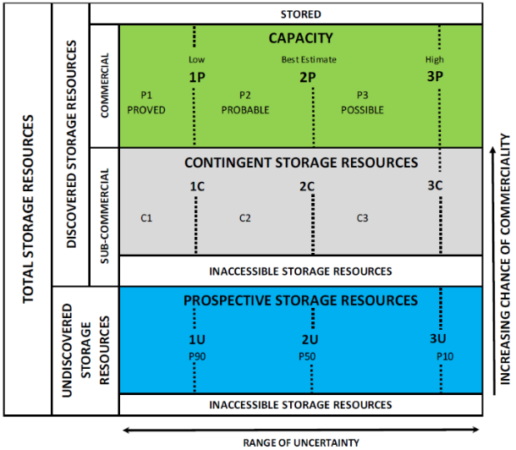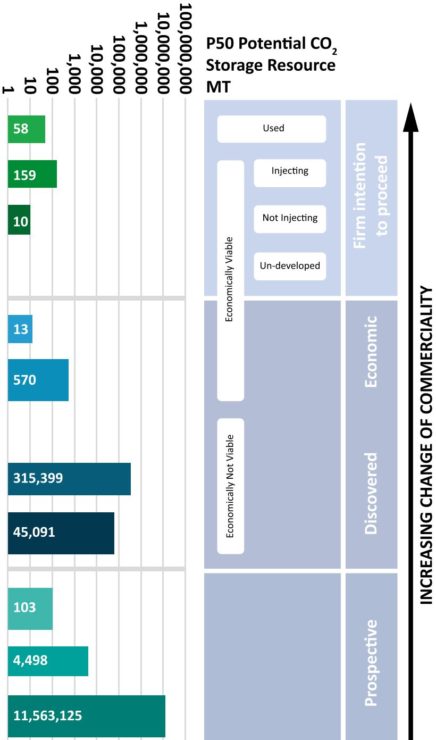Insights and Commentaries
New international system for classifying storage resources provides further confidence in CCS
2nd May 2019
Topic(s): CO2 storage, SRMS
The theoretical capacity of carbon dioxide (CO2) storage resources has always been higher than the CO2 storage required to meet the projections of any climate change scenario. In addition, the recent IPCC Special Report cited the availability of abundant storage resources to meet 1.5oC scenarios (IPCC, 2018, pp. Chapter 2-57).
However, historically, there have been significant levels of scepticism and low confidence in published storage numbers. This is largely due to the previous decades’ approach to quantifying storage formations that included an array of very different methodologies and definitions. To date, no two published assessments use the exact same method, data or definitions; meaning no two national assessments can be directly compared.
It became clear that, in the same way that gas and oil reserves are classified by the petroleum resource management scheme (PRMS), CO2 storage resources needed a system.
Proposing a new international system
In 2016, the Society of Petroleum Engineers (SPE) sponsored the production of a system based on the well-established PRMS. The result was SPE’s adoption and approval of the CO2 Storage Resources Management System (SRMS) in 2017 (SPE, 2017). The full guidelines will be published in late 2019.
SRMS is not about the available geology, as has previously been the case. This system is about the commercialisation of storage formations. Being commercially focussed, the SRMS’ classification and categorisation uses common terminology, instinctive criteria, and clear definitions to classify storage resources. This results in:
- Easy uptake from non-technical users
- Broader confidence in storage estimates
- A reduction in the technical uncertainty that often plagues storage estimates.

Figure 1. The published Storage Resources Classification framework (SPE, 2016)
The SRMS explained further
In the SRMS, storage formations are classified into discovered and undiscovered (see Figure 1). The former requires adequate subsurface data to assess the storage formation– such as a storage appraisal well. Storage formations are further classified into:
- Stored
- Capacity
- Contingent resources
- Prospective resources
An additional classification, ‘inaccessible’ is generally attributed to those storage formations that cannot be used, such as areas with prohibitive legal and regulatory regimes for storage, or physical access (e.g. underlies an urban area).
The highest classification (and confidence) is ‘CO2 stored’. Put simply, this is when a carbon capture and storage (CCS) facility injects and stores CO2. Storage ‘capacity’ is only used when the storage formation is deemed commercially viable and ready to proceed but hasn’t injected CO2. Under this classification key contingencies have been met, which could include:
- Technical (e.g. CO2 source, surface infrastructure approved, injection strategy, etc. amongst many others)
- Regulatory
- Economic
- Social
‘Contingent’ resources means one or more of the contingencies outlined above were not met. Prospective resources range from desktop studies and more generalised exploration-based assessments, where specific data such as a storage well has not been drilled. Most storage assessments to date fall are prospective resources. This classification is also the broadest in terms of definition and scope.
Each classification is then categorised into the high (P90), best estimate (P50) and low (P10). Further delineating, these categories provides a level of confidence within each classification.
Initial SRMS application
Preliminary work published by the OGCI (2017) to apply the SRMS on seven regional assessments (as seen in Figure 2) has found:
- 12,000 Gt of storage resources defined within the SRMS as being on the path to commercial viability
- Over 300 Gt of storage is deemed sub-commercial and with further refinement could become CCS ready
- Only 200 Mt of storage capacity is currently commercially ready for deployment or being actively used.

Figure 2. Preliminary results of seven regional CO2 storage assessments using the SRMS. Note: results do not include all storage assessments within the seven countries and only represents national assessments. After: OGCI (2017).
Outlook
Applying the SRMS based on the internationally-adopted petroleum classification method enables a user-friendly methodology and will increase wider adoption. The adoption of the SPE’s storage system will enable future assessments to be better defined and compared across jurisdictions. The SRMS does require further refinement especially in the broader basin-scale definitions within prospective storage resources. However, using this system will increasingly mean that we can say, with even further confidence, that there is more underground CO2 storage resource than is needed to meet Paris climate targets.
Works Cited
IPCC, 2018. Summary for Policymakers. In: M. e. al., ed. Global Warming of 1.5°C. An IPCC Special Report on the impacts of global warming of 1.5°C above pre-industrial levels and related global greenhouse gas emission pathways, in the context of strengthening the global response to the threat of climate change,. Geneva: World Meteorological Organization, p. 32.
Oil and Gas Climate Initiative, 2017. Preliminary Multinational CO2 Storage Resource Assessment, s.l.: Oil and Gas Climate Initiative.
SPE, 2017. CO2 Storage Resources Management System, Society of Petroleum Engineers.